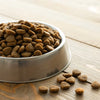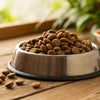Can I Give My Dog Wet and Dry Food? Understanding the Benefits of Mixing
- Houndsy
Table of Contents
- Introduction
- The Basics of Dog Food: Wet vs. Dry
- The Benefits of Mixing Wet and Dry Dog Food
- Considerations When Mixing Wet and Dry Food
- How to Mix Wet and Dry Dog Food Effectively
- Conclusion
Introduction
Did you know that nearly 70% of dog owners mix wet and dry food for their furry companions? This practice isn't just a trend; it's a method backed by benefits that can enhance your dog's nutrition and dining experience. As pet parents, we often seek ways to optimize our dog's diet, making meals more enjoyable while ensuring they receive the necessary nutrients. In this blog post, we will explore the question, "Can I give my dog wet and dry food?" and delve into the advantages and considerations of this mixed feeding approach.
By the end of this article, you will have a comprehensive understanding of the benefits of combining wet and dry dog food, how to do it effectively, and what factors to consider based on your dog’s specific needs. We invite you to reflect on your own pet feeding routines and consider how a mixed diet could enhance your dog's mealtime experience.
Thesis Statement
Mixing wet and dry food can provide a balanced diet, enhance palatability, and encourage hydration, but it's essential to approach this feeding method thoughtfully to meet your dog's unique needs.
The Basics of Dog Food: Wet vs. Dry
Before we dive into the benefits of mixing wet and dry food, let's clarify the fundamental differences between these two types of dog food.
What is Dry Dog Food?
Dry dog food, commonly known as kibble, is created by cooking and dehydrating ingredients, resulting in a product that contains approximately 10-12% moisture. The key characteristics of dry dog food include:
- Convenience: Kibble is easy to store, measure, and serve. It has a long shelf life and doesn't require refrigeration once opened.
- Dental Health: The texture of dry food can help reduce plaque and tartar buildup, promoting better oral health.
- Cost-Effectiveness: Generally, dry food is less expensive than wet food, making it a budget-friendly option for pet parents.
What is Wet Dog Food?
Wet dog food, available in cans or pouches, contains a much higher moisture content—typically around 75-78%. Its characteristics include:
- Enhanced Flavor: The aroma and texture of wet food can make meals more enticing, especially for picky eaters.
- Hydration: Wet food provides additional moisture, which is beneficial for dogs that may not drink enough water.
- Easier to Chew: The soft texture of wet food makes it easier for puppies, senior dogs, or those with dental issues to consume.
The Benefits of Mixing Wet and Dry Dog Food
Combining wet and dry dog food can offer several benefits that cater to your dog's dietary preferences and health needs. Here are some key advantages:
1. Improved Palatability
Combining the two types of food can create a more appetizing meal. The enticing aroma of wet food can encourage dogs to eat, especially for those who may be hesitant to finish their kibble. This is particularly important for dogs with reduced appetites or those recovering from illness.
2. Enhanced Nutritional Balance
Mixing wet and dry food allows pet parents to provide a more balanced diet. Dry food typically offers essential nutrients in a concentrated form, while wet food can introduce additional moisture and flavor. Together, they can meet a dog's nutritional requirements more effectively.
3. Increased Hydration
Adding wet food to your dog's diet helps increase their overall water intake, which is crucial for maintaining proper kidney function and hydration. This is especially beneficial for dogs prone to urinary issues or those that don't drink enough water.
4. Variety and Excitement
Just as we enjoy variety in our meals, dogs can benefit from a diverse diet too. Mixing wet and dry food can add excitement to mealtime, reducing boredom and encouraging dogs to engage with their food.
5. Weight Management
For dogs that are overweight or need to maintain a healthy weight, mixing wet food can help control caloric intake while ensuring they feel full and satisfied. Wet food is lower in calories per volume, allowing pet parents to provide larger portions without overfeeding.
Considerations When Mixing Wet and Dry Food
While there are numerous benefits to mixing wet and dry food, it's important to approach this practice thoughtfully. Here are some considerations to keep in mind:
1. Balance Ratios
The ratio of wet to dry food can significantly impact your dog's overall nutrition. A common recommendation is to use approximately 75% dry food and 25% wet food, but this can vary based on your dog's age, weight, and activity level. Always consult with your veterinarian to determine the best ratio for your dog.
2. Monitor Caloric Intake
When mixing dog food types, it's crucial to monitor your dog's total caloric intake to avoid overfeeding. Keep track of the calories in both the wet and dry food, along with any treats, to ensure your dog maintains a healthy weight.
3. Storage and Freshness
Wet food needs to be consumed relatively quickly once opened, usually within 24 hours, unless refrigerated. This requires proper storage to prevent spoilage. Dry food, on the other hand, can last longer, but it's essential to keep it sealed to maintain freshness.
4. Individual Health Needs
Every dog is unique, and some may have specific dietary restrictions or health conditions that require careful consideration when mixing foods. For instance, dogs with certain medical conditions may need to follow a specific diet that doesn't allow for mixing. Always consult your veterinarian regarding any dietary changes.
How to Mix Wet and Dry Dog Food Effectively
To ensure a successful mixed feeding approach, follow these practical tips:
1. Start Slow
Introduce mixed feeding gradually to allow your dog to adjust. Start by adding a small amount of wet food to their dry kibble and gradually increase the proportion over a few days.
2. Choose High-Quality Products
Select high-quality wet and dry foods that are complete and balanced according to AAFCO (Association of American Feed Control Officials) standards. This ensures your dog gets the necessary nutrients from both types of food.
3. Monitor Your Dog’s Response
Observe how your dog reacts to the mixed meals. Look for signs of enjoyment, increased appetite, or any digestive issues. If any negative reactions occur, consult your veterinarian.
4. Adjust as Needed
Be flexible with your mixing ratios based on your dog's preferences and health needs. If your dog seems to prefer one type over the other, adjust accordingly while keeping nutritional balance in mind.
Conclusion
Mixing wet and dry dog food can be a delightful way to enhance your dog's dining experience while ensuring they receive a balanced diet. By understanding the benefits and considerations of this feeding method, we can make informed decisions that cater to our dogs’ unique needs.
We encourage you to reflect on your dog's feeding routine and consider incorporating a mix of wet and dry food into their diet. If you're looking for a way to elevate your dog's feeding experience further, check out the Houndsy Kibble Dispenser—designed to simplify and enhance the dog feeding ritual.
FAQ
1. Can I mix any brand of wet and dry food?
While mixing brands is possible, it's best to use products from the same manufacturer or those recommended by your veterinarian. This ensures compatibility in terms of nutritional balance.
2. How often should I mix wet and dry food?
This can vary based on your dog's preferences. Some pet parents mix every meal, while others may do it a few times a week. Monitor your dog's response for the best approach.
3. Is it safe to mix wet and dry food?
Yes, mixing wet and dry food is generally safe for healthy dogs. However, consult your veterinarian if your dog has specific health concerns or dietary restrictions.
4. Will mixing wet and dry food affect my dog's dental health?
While wet food does not provide the same dental benefits as dry kibble, the combination can still be beneficial. Regular dental check-ups and care are essential to maintain your dog's oral health.
5. How should I store opened wet food?
Once opened, wet food should be covered and refrigerated to maintain freshness. Use it within 24-48 hours for best results.
By thoughtfully mixing wet and dry dog food, we can enhance our dogs' mealtime experience and contribute to their overall well-being. Happy feeding!












